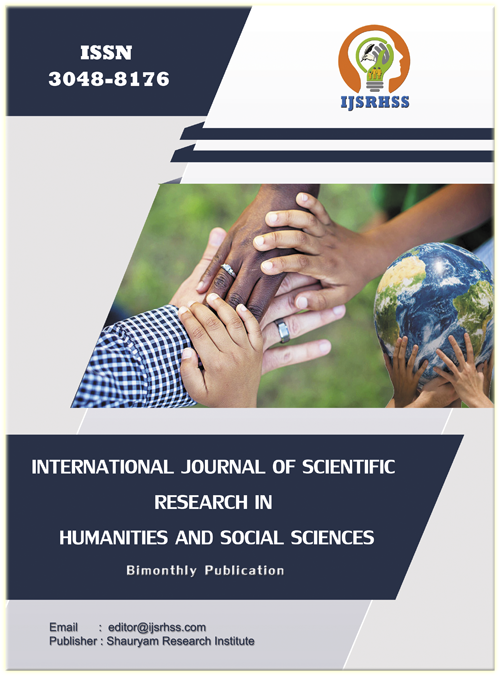Strategic Workforce Transformation and Hybrid Work Culture: An Empirical Study of Corporate HR Practices in Korba, Chhattisgarh
DOI:
https://doi.org/10.32628/IJSRHSS25247Keywords:
Hybrid Work Model, Human Resource Management, Employee Productivity, Workforce Engagement, Remote Work ChallengesAbstract
The transformation of traditional workplace dynamics, accelerated by global disruptions, has led to the emergence and adoption of hybrid work models, blending remote and in-office operations. This study investigates the strategic implications of hybrid work on human resource (HR) management, employee productivity, and organizational effectiveness, specifically in the corporate sector of Korba. It aims to evaluate the perception of employees toward inclusion, access to resources, communication flow, and HR-related challenges within the hybrid work environment. The research also explores the influence of hybrid strategies on employee retention and the extent of organizational preparedness in terms of infrastructure, policy clarity, and managerial capability. Using a structured questionnaire, primary data were collected from 384 respondents across various corporates operating in Korba. Descriptive statistics, correlation analysis, ANOVA, and regression models were applied to test the formulated hypotheses. The findings reveal that strategic HR practices have a significant relationship with the successful implementation of hybrid work. Additionally, the hybrid work model positively impacts employee satisfaction and productivity, although challenges related to supervision, engagement, and professional isolation persist. A notable difference in HR challenges was observed across different work setups fully remote, hybrid, and traditional models. The study concludes that while hybrid work offers flexibility and enhanced performance potential, its success is contingent upon adaptive HR policies, robust digital infrastructure, and inclusive organizational practices. Based on the results, several recommendations are proposed, including strengthening HR frameworks, enhancing communication, fostering mental well-being, investing in digital tools, and promoting employee participation in policy-making. These strategies not only help mitigate challenges but also facilitate sustainable workforce transformation in the post-pandemic era. This research contributes to the growing body of literature on hybrid work culture and serves as a practical guide for HR leaders and decision-makers aiming to optimize hybrid work frameworks in regional corporate settings.
Downloads
References
Bersin, J. (2021). Workforce Transformation in the Post-COVID Era: The Role of Skills, Agility, and Resilience. Deloitte Insights.
Gartner. (2022). Future of Work Trends Post-COVID-19: Embracing Hybrid. Retrieved from www.gartner.com
Harvard Business Review. (2021). How to Do Hybrid Right. May 2021 Issue.
Ulrich, D., Brockbank, W., Younger, J., & Ulrich, M. (2020). Victory Through Organization: Why the War for Talent is Failing Your Company and What You Can Do About It. McGraw Hill.
Agarwal, R., & Srivastava, R. (2022). Hybrid Work Culture in India: Emerging Challenges and HR Strategies. International Journal of Management Studies, 9(2), 34-45.
Barney, J. (1991). Firm Resources and Sustained Competitive Advantage. Journal of Management, 17(1), 99–120. https://doi.org/10.1177/014920639101700108
Choudhury, P., Foroughi, C., & Larson, B. (2020). Work-from-anywhere: The productivity effects of geographic flexibility. Strategic Management Journal, 42(4), 655-683. https://doi.org/10.1002/smj.3251
Kotter, J. P. (1996). Leading Change. Harvard Business School Press.
Kniffin, K. M., Narayanan, J., Anseel, F., et al. (2021). COVID-19 and the Workplace: Implications, Issues, and Insights for Future Research and Action. American Psychologist, 76(1), 63–77. https://doi.org/10.1037/amp0000716
Tiwari, M., & Singh, V. (2023). Human Resource Challenges in Indian Industrial Townships: A Regional Analysis. Journal of Regional Development and Planning, 12(1), 55-70.
Waizenegger, L., McKenna, B., Cai, W., & Bendz, T. (2020). An affordance perspective of team collaboration and enforced working from home during COVID-19. European Journal of Information Systems, 29(4), 429–442. https://doi.org/10.1080/0960085X.2020.1800417
Becker, G. S. (1964). Human Capital: A Theoretical and Empirical Analysis with Special Reference to Education. University of Chicago Press.
Barney, J. (1991). Firm resources and sustained competitive advantage. Journal of Management, 17(1), 99–120.
Cappelli, P., & Keller, J. R. (2017). The historical context of talent management. Journal of Organizational Effectiveness: People and Performance, 4(4), 291–299.
Cascio, W. F., & Montealegre, R. (2016). How technology is changing work and organizations. Annual Review of Organizational Psychology and Organizational Behavior, 3(1), 349–375.
Choudhury, P., Foroughi, C., & Larson, B. Z. (2020). Work-from-anywhere: The productivity effects of geographic flexibility. Strategic Management Journal, 42(4), 655–683.
Eurofound. (2021). Telework and the COVID-19 pandemic: A new way of working? Publications Office of the European Union.
Kniffin, K. M., Narayanan, J., Anseel, F., et al. (2021). COVID-19 and the workplace: Implications, issues, and insights for future research and action. American Psychologist, 76(1), 63–77.
Kotter, J. P. (1996). Leading Change. Boston: Harvard Business School Press.
Lewin, K. (1947). Frontiers in group dynamics: Concept, method and reality in social science. Human Relations, 1(1), 5–41.
Waizenegger, L., McKenna, B., Cai, W., & Bendz, T. (2020). An affordance perspective of team collaboration and enforced working from home during COVID-19. European Journal of Information Systems, 29(4), 429–442. Reference: Barney, J. (1991). Firm resources and sustained competitive advantage. Journal of Management, 17(1), 99–120.
Scott, W. R. (2008). Institutions and Organizations: Ideas and Interests (3rd ed.). Sage Publications.
Lewin, K. (1951). Field Theory in Social Science. Harper & Row.
Kotter, J. P. (1995). Leading Change: Why Transformation Efforts Fail. Harvard Business Review, 73(2), 59–67.
Demerouti, E., Bakker, A. B., Nachreiner, F., & Schaufeli, W. B. (2001). The Job Demands-Resources Model of Burnout. Journal of Applied Psychology, 86(3), 499–512.
Greenhaus, J. H., & Beutell, N. J. (1985). Sources of Conflict Between Work and Family Roles. Academy of Management Review, 10(1), 76–88.
Clark, S. C. (2000). Work/Family Border Theory: A New Theory of Work/Family Balance. Human Relations, 53(6), 747–770.
Frone, M. R. (2003). Work-family balance. In J. C. Quick & L. E. Tetrick (Eds.), Handbook of Occupational Health Psychology (pp. 143–162). American Psychological Association.
Demerouti, E., Bakker, A. B., Nachreiner, F., & Schaufeli, W. B. (2001). The Job Demands-Resources Model of Burnout. Journal of Applied Psychology, 86(3), 499–512.
Deloitte Insights. (2023). 2023 Global Human Capital Trends.
Downloads
Published
Issue
Section
License
Copyright (c) 2025 International Journal of Scientific Research in Humanities and Social Sciences

This work is licensed under a Creative Commons Attribution 4.0 International License.




